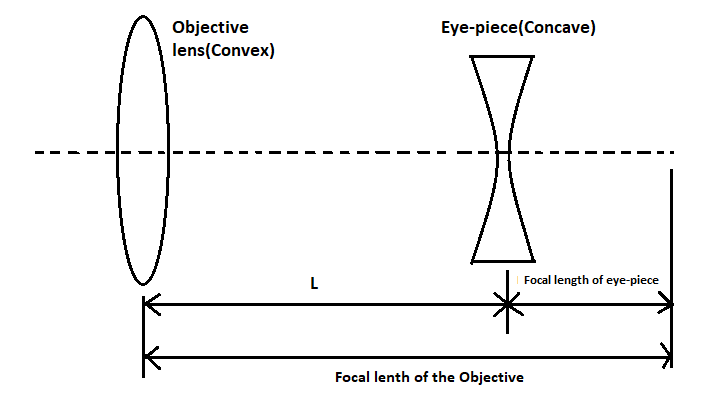
A Galilean telescope measures 9 cm from the objective to the eye-piece. The focal length of the objective is 15 cm. Its magnifying power is
A. $2.5$
B. $\dfrac{2}{5}$
C. $\dfrac{5}{3}$
D. $\dfrac{3}{5}$
Answer
532.8k+ views
Hint: In a Galilean telescope, the focal length of the objective lens is equal to the difference between the length between the two lenses and the focal length of the eye-piece, ${f_o} = L + {f_e}$, where ${f_o},{f_e}$ are the focal lengths of objective lens and eye-piece, L is the distance between them. Substitute the values of L and focal length of the objective lens to find the value of focal length of the eye-piece. Magnification is the negative ratio of focal length of the objective lens and focal length of the eye-piece.
Complete step by step answer:
 We are given that a Galilean telescope measures 9 cm from the objective to the eye-piece and the focal length of the objective is 15 cm.
We are given that a Galilean telescope measures 9 cm from the objective to the eye-piece and the focal length of the objective is 15 cm.
We have to find its magnifying power.
As we can see in the above figure, the objective is a convex lens and the eye-piece is a concave lens.
So the focal length is negative for the concave (eye-piece) lens.
As we can see, the focal length of the objective lens is the sum of the focal length of the eye-piece and the distance between them.
${f_o} = L + {f_e}$, where ${f_o},{f_e}$ are the focal lengths of objective lens and eye-piece, L is the distance between them and ${f_e}$ should be taken negatively.
$
{f_o} = L + \left( { - {f_e}} \right) \\
\implies {f_o} = L - {f_e} \\
\implies {f_e} = L - {f_o} \\
$
Substitute the values of the L and ${f_o}$ as they are given in the question.
$
{f_o} = 15cm,L = 9cm \\
\implies {f_e} = L - {f_o} \\
= 9 - 15 \\
\therefore {f_e} = - 6cm \\
$
Magnification is the negative ratio of focal length of the objective lens and focal length of the eye-piece.
$
m = \dfrac{{ - {f_o}}}{{{f_e}}} \\
{f_o} = 15cm,{f_e} = - 6cm \\
m = \dfrac{{ - 15}}{{ - 6}} \\
\implies m = \dfrac{5}{2} \\
\therefore m = + 2.5 \\
$
The magnifying power of the given Galilean telescope is 2.5.
So, the correct answer is “Option A”.
Note:
The objective lens is concave, which is a spherical lens and focuses the light rays passed through it to a specific point. Eye-piece is a convex lens, which is a spherical lens and diverges the light rays refracted from it. The lenses used in objective and eye-piece are not the same in a Galilean telescope. Be careful in considering the lenses.
Complete step by step answer:

We have to find its magnifying power.
As we can see in the above figure, the objective is a convex lens and the eye-piece is a concave lens.
So the focal length is negative for the concave (eye-piece) lens.
As we can see, the focal length of the objective lens is the sum of the focal length of the eye-piece and the distance between them.
${f_o} = L + {f_e}$, where ${f_o},{f_e}$ are the focal lengths of objective lens and eye-piece, L is the distance between them and ${f_e}$ should be taken negatively.
$
{f_o} = L + \left( { - {f_e}} \right) \\
\implies {f_o} = L - {f_e} \\
\implies {f_e} = L - {f_o} \\
$
Substitute the values of the L and ${f_o}$ as they are given in the question.
$
{f_o} = 15cm,L = 9cm \\
\implies {f_e} = L - {f_o} \\
= 9 - 15 \\
\therefore {f_e} = - 6cm \\
$
Magnification is the negative ratio of focal length of the objective lens and focal length of the eye-piece.
$
m = \dfrac{{ - {f_o}}}{{{f_e}}} \\
{f_o} = 15cm,{f_e} = - 6cm \\
m = \dfrac{{ - 15}}{{ - 6}} \\
\implies m = \dfrac{5}{2} \\
\therefore m = + 2.5 \\
$
The magnifying power of the given Galilean telescope is 2.5.
So, the correct answer is “Option A”.
Note:
The objective lens is concave, which is a spherical lens and focuses the light rays passed through it to a specific point. Eye-piece is a convex lens, which is a spherical lens and diverges the light rays refracted from it. The lenses used in objective and eye-piece are not the same in a Galilean telescope. Be careful in considering the lenses.
Recently Updated Pages
Master Class 12 Business Studies: Engaging Questions & Answers for Success

Master Class 12 Economics: Engaging Questions & Answers for Success

Master Class 12 English: Engaging Questions & Answers for Success

Master Class 12 Maths: Engaging Questions & Answers for Success

Master Class 12 Social Science: Engaging Questions & Answers for Success

Master Class 12 Chemistry: Engaging Questions & Answers for Success

Trending doubts
Which are the Top 10 Largest Countries of the World?

Differentiate between homogeneous and heterogeneous class 12 chemistry CBSE

Why is the cell called the structural and functional class 12 biology CBSE

Who discovered the cell and how class 12 biology CBSE

What is the Full Form of PVC, PET, HDPE, LDPE, PP and PS ?

Derive an expression for electric potential at point class 12 physics CBSE




